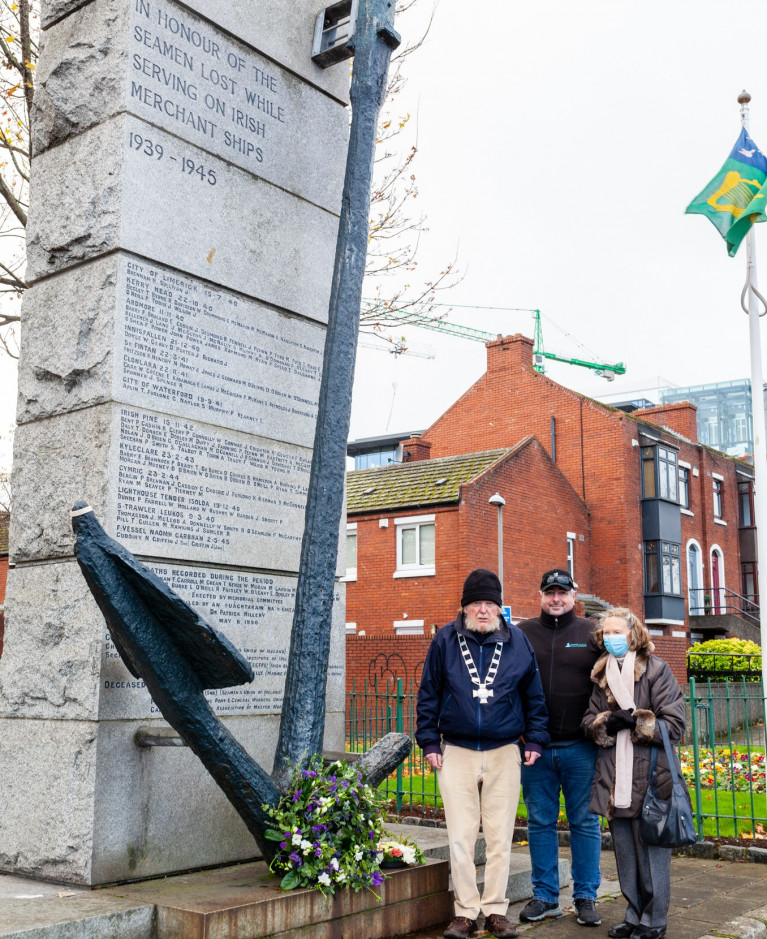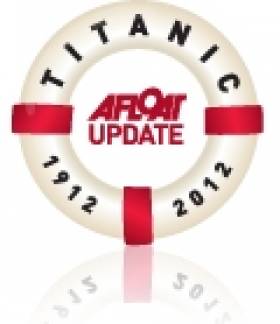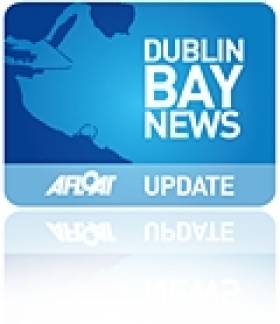Displaying items by tag: Maritime Institute of Ireland
The annual Irish Seaman's National Memorial service this year was again cancelled given ongoing Covid circumstances, however a small low-key ceremony did take place along Dublin's south quays, writes Jehan Ashmore.
Attending the ceremony last Friday at City Quay, was the president of the Maritime Institute of Ireland, Joe Varley, who laid a wreath on behalf of the Institute at the Seafarers Memorial monument.
In addition a second wreath was laid by Rose Kearney on behalf of the Stella Maris Seafarers Mission with their club and centre located across the Liffey, on Beresford Place near to Busaras.
Normally the ceremony which is also attended by other maritime organisations, is to remember those Irish Seafarers who were lost while serving on Irish merchant ships during World War II.
The ceremony which is organised by the M.I.I., had in the previous month marked its 80th anniversary as the Maritime Institute of Ireland was incorporated during WW2 in October 1941.
Asides the role of the Institute, they opened the Maritime Museum in Dun Laoghaire in 1978 which is located aptly in the former Church of Ireland Old Mariners' Church. The atmospheric 180 year-old historic building (near the East Pier) is located opposite of the DLRCoCo's LexIcon Library.
To read much more about the history of the M.I.I. and the National Maritime Museum of Ireland which includes a gift shop and library, click here.
Maritime Institute of Ireland to Hold AGM
#MaritimeInstitute - The AGM of the Maritime Institute of Ireland, whose patron is President Michael D. Higgins, is to be held next Saturday 18 October in the institute's National Maritime Museum of Ireland, Dun Laoghaire.
Members of the M.I.I are invited to attend the AGM which starts at 12 noon. The museum located in the former Mariner's Church is where 14 of its parishioners were killed in World War I and this will be acknowledged during the meeting.
The museum which is open to members free of charge is also open to the public, where in addition to the many diverse and interesting exhibits on display, there is a library, souvenir gift shop and café.
In recent years the museum underwent a major refursbishment, for a 3D tour of the museum click HERE. To activate, click on map to launch 3D interactive viewing. For further information about the visitor attraction visit: www.mariner.ie
Museum Festive Concert: Il Coro Italiano di Dublino
#MUSEUM CONCERT – Getting into the festive spirit on Saturday 1 December will be a concert of opera choruses, folk songs Christmas music and distinguished soloists performed by "Il Coro Italiano di Dublino" in the National Maritime Museum of Ireland, Dun Laoghaire.
Il Coro Italiano di Dublino was founded in 1986 by Dr. Rosa Maria Chicco-Ferraro, Deputy Head of Mission at the Italian Embassy in Dublin at that time. The present name of the choir was adopted in 2002.
Tickets cost €10 each for the concert that starts at 7.30pm in the renovated surroundings of the former Mariners Church. For further events and daytime visiting hours (including Mondays) of the museum visit: www.mariner.ie
AGM of Maritime Institute of Ireland
#MUSEUM AGM - The Maritime Institute of Ireland's AGM is to take place on Saturday 6 October in the National Maritime Museum of Ireland, in Dun Laoghaire, writes Jehan Ashmore.
The museum which is housed in the former Old Mariners Church was re-opened in April after several years of closure so to carry out an extensive renovation and modernisation programme.
The M.I.I. fosters an appreciation of Irish maritime heritage and through operating the museum, they also host lectures, issue newsletters, host and support commemorations, conduct research and publish papers. In addition they intend to re-instate a library which includes an impressive collection of Lloyds Register of Shipping volumes.
The institute is a totally voluntary body, without regular finance from any quarter. New members are welcome as are volunteers. For information including how to make a voluntary donation visit: www.mariner.ie
National Heritage Week: Maritime Lecture Programme
#MARINE HERITAGE – Up and down the country, events are been held for the annual National Heritage Week including a series of maritime lectures as previously reported on Afloat.ie
Below is a full detailed description of the varied topics of the lecture programme which is to be held in the Dun Laoghaire Club, Eblana Avenue (off Marine Road) on the final day (Sunday 26th August) of the heritage week.
12 noon The 'Kowloon Bridge' and her sisters – by Garda Diver Peter Brady.
1.15 pm A West of Ireland view of the Battle of the Atlantic – by Dr. Michael Kennedy, Royal Irish Academy.
3.00 pm Early navigation in Ireland / maritime archaeology of Sligo harbour and bay.- by Auriel Robinson DAHG.
4.15 pm Captain Bligh and Dublin Bay- speaker, Terry Cummins of the Irish Naval Association.
6.00 pm The greatest naval catastrophe in England's history-concealed throughout history by Elizabethan propaganda historiography.
This lecture is to be presented by special guest speaker; Dr. Luis Gorrochategui Santos – who is visiting Ireland especially for the heritage week lectures organised by the Maritime Institute of Ireland (M.I.I.) which runs the National Maritime Museum of Ireland.
For further information about the day's lecture contact Barney Yourell on 087 9007466
Admission is free, noting there is a recommended donation of €10
Titanic In Song
#TITANIC IN SONG – A musical evening 'Titanic in Song' by Dara MacMahon and Gerry Noonan accompanied by Pauline Cooper will be held in the National Maritime Museum of Ireland, Dun Laoghaire on Friday 15th June. Tickets cost €10 each and the event starts at 8 o'clock.
Explore the Titanic story through the songs heard and played by the passengers on the ship. From the light classical and musical comedy numbers familiar to the 1st and 2nd class passengers to the music hall, vaudeville and Irish songs popular in steerage. The evening will present a unique look at the music played on that fateful journey.
The museum which is run by volunteers and members of the Maritime Institute of Ireland was re-opened last month after years of renovation work was carried out at the former Old Mariners Church. For further information and on the museum and its activities visit www.mariner.ie
Lecture: Sinking of Submarine HMS Thetis
#LECTURE – A lecture about the sinking of HMS Thetis will be held in the Dun Laoghaire Club, 3 Eblana Avenue next Monday 14th May. The talk will be presented by David Roberts MA -BBC marine presenter.
Roberts will tell the story of the 1939 submarine disaster in Liverpool Bay when 99 men were left to die while carrying out trials. In addition about the delays, mistakes and indecision of the disgraceful cover-up by the Churchill Government and the shocking treatment of those who were left behind.
Standard tickets cost €10 and €5 for concessions and to members of the Maritime Institute of Ireland (M.I.I.). Tickets can be purchased from their maritime museum shop which is on the top (3rd floor) of the Dun Laoghaire Shopping Centre. For further information Tel: 01-2143964 or 085-7528737 and in general about the maritime museum visit www.mariner.ie
Belfast Commemoration to Lives Lost at Sea
#EVENTS – The annual commemoration for those who have no grave but the sea, will be held in Belfast next Sunday 13th May.
The event is to be hosted by the Merchant Navy Association of Northern Ireland and where members of the Maritime Institute of Ireland based in Dun Laoghaire's Maritime Museum which opened a month ago, are due to attend.
Those intending to travel to the commemoration are invited to contact the museum's shop which is located on the top (3rd floor) of the Dun Laoghaire Shopping Centre.
For further information about the M.I.I. and the museum visit www.mariner.ie
Maritime Institute to Host Tributes to Titanic
#TITANIC 100 – In this centenary week of the sinking of RMS Titanic a talk and musical tribute will be held in memory of the disaster this evening (8 pm) in the newly opened maritime museum in Dun Laoghaire as previously reported on Afloat.ie.
Deep-sea diver Rory Golden became the first Irishman to see the wreck of the Titanic and he will present an illustrated lecture. The musical tribute will be led by uillinn piper Eamon Galdubh – where similar music will be aired to that played in the 2nd and 3rd class compartments on the Titanic.
In addition the Maritime Institute of Ireland (M.I.I.) which runs the museum will run its final lecture for the season next week. The lecture 'Titanic -Locked in History' which will be held next Thursday (19th April) at 8pm in the Stella Maris Seafarers Club in Dublin city-centre and is to be presented by Michael O'Flaherty.
For information on both the Titanic Tribute evening (tickets cost €10) call 087 900 7466 and by also viewing the website which includes details about next week's admission free lecture visit: www.mariner.ie
Easter Sunday Marks Rebirth of Mariners Maritime Museum
#MARTIME MUSEUM AT EASTER - Earlier this week Dun Laoghaire's maritime museum re-opened its doors to the public after a €4m renovation project was carried out on the apt venue of the former Mariners Church, which incidentally closed on this Easter Day forty years ago, writes Jehan Ashmore.
With a new lease of life the extensively renovated and upgraded museum can look forward to a future. Visitors enter the museum at a new entrance, where in the reception foyer there is a souvenir shop, beyond that in the main body or nave are exhibits displayed, each telling a story and for children there is a Knott Station. To view the initial exhibits on display, click HERE.
In addition there is new facility in the form of a café, which was much needed and where two new stained -glass windows by Peadar Lamb feature, they were sponsored by the Dun Laoghaire Harbour Company. As for the original stained-class windows they were restored to their full glory.
The renovation began in 2006 and was funded by the Government which led to a three-phrased project that involved work carried out from the re-roofing right down to the floorboards. Walls were re-plastered, electric systems modernised and wheel chair-lift and ramps installed.
Work also took place to clean the exterior of the stone-cut granite building hewn from Dalkey Quarry and which led to the consecration of the Kingstown Episcopalian Mariners Church in 1843.
After many generations of mariners and their families, parish numbers dwindled and its use as place worship ended on Easter Sunday 1972. The Maritime Institute of Ireland which runs the museum relocated two years later having had a smaller museum sited along the town's harbour waterfront.
For the next three decades the museum which has attracted locals and visitors from home and overseas, eventually had to close due to deteriorating conditions of an aging building.
Now that the museum is up and running, the M.I.I. which is staffed by volunteers has in recent years also had the support of a FAS scheme of workers, which according to the institute have been invaluable.
The museum is open 11am to 5pm Tuesday to Sunday and every Bank Holiday, for further information visit: www.mariner.ie

































































